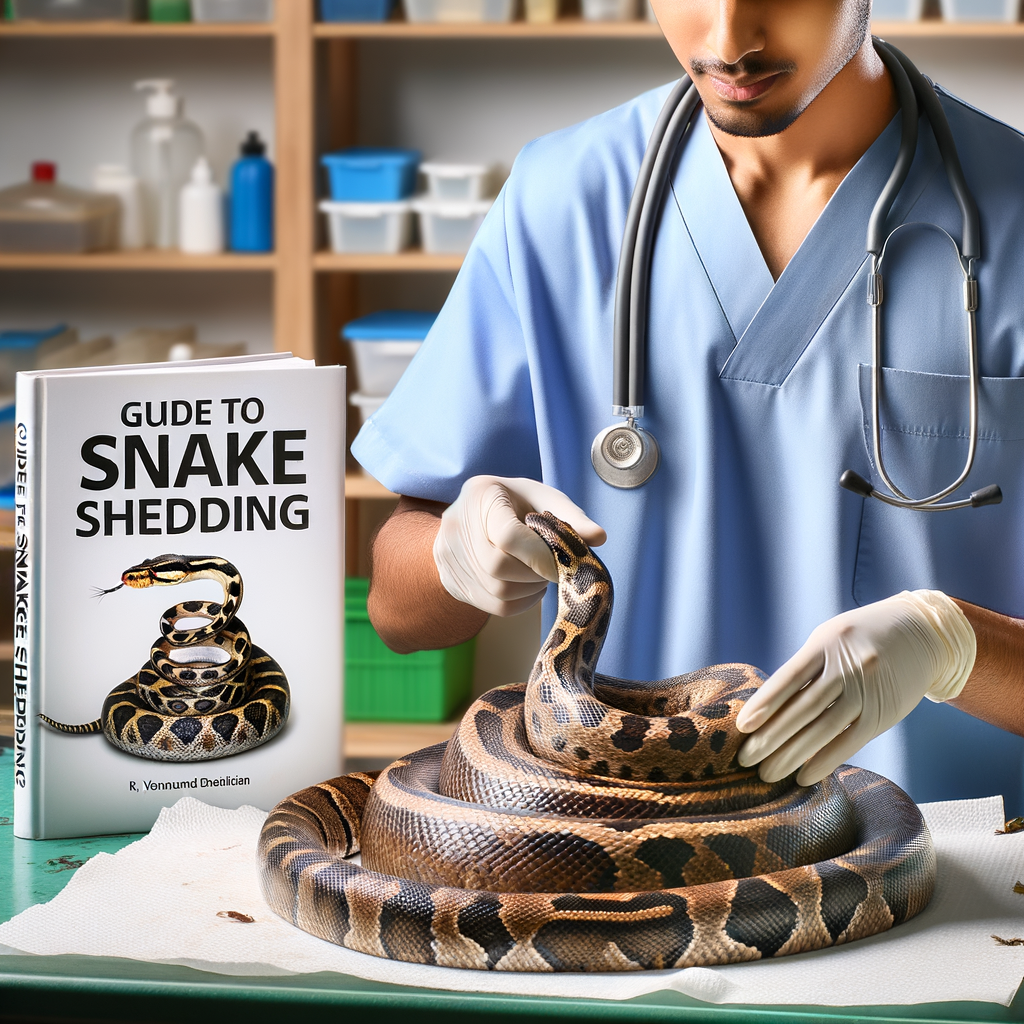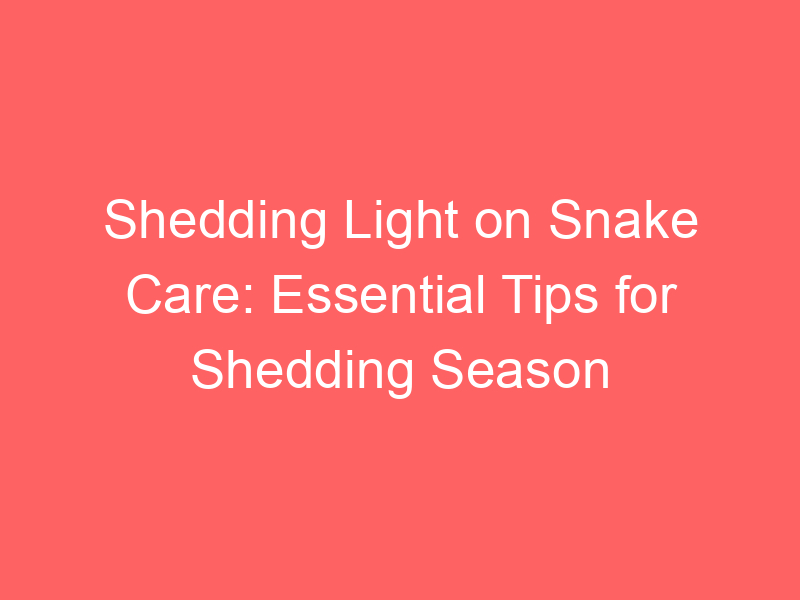
Introduction to Snake Shedding
Snake shedding is a natural process that all snakes go through. It’s a fascinating part of a snake’s life cycle and is essential for their growth and health. In this section, we will explore what snake shedding is, why it’s important, and how to properly care for a shedding snake.
- Understanding the snake shedding process
- The importance of proper snake shedding care
The process of snake shedding, also known as ecdysis, is when a snake removes its old, outer layer of skin. This happens because snakes, unlike humans, don’t grow continuously. Instead, they grow in stages, and each stage is marked by a shedding process.
Before a snake begins to shed, it will usually stop eating and find a safe place to hide. Its eyes may also turn a milky blue color. This is because a layer of fluid is forming between the old skin and the new skin underneath. After a few days, the snake’s eyes will clear up, and it will begin to shed its skin.
The snake will usually start the shedding process by rubbing its nose against a rough surface. This helps to loosen the old skin. Then, the snake will wriggle its way out of the old skin, often turning it inside out in the process. Once the shedding is complete, the snake will have a fresh, new layer of skin.
Proper care during the shedding process is crucial for a snake’s health. If a snake doesn’t shed its skin properly, it can lead to health problems. For example, pieces of the old skin can get stuck on the snake’s body, causing discomfort and potentially leading to infections.
As a snake owner, it’s important to monitor your snake during the shedding process to ensure everything goes smoothly. This includes maintaining the right humidity levels in the snake’s enclosure, providing rough surfaces for the snake to rub against, and checking the snake after the shedding process to make sure all of the old skin has been removed.
In the following sections, we will delve deeper into the snake shedding process, provide a step-by-step guide on how to care for a shedding snake, and share some case studies on snake shedding care. We will also discuss shedding in other reptiles and provide key takeaways on ensuring proper snake shedding care.
Guide to Snake Shedding
Understanding the process of snake shedding is crucial for any snake owner. This guide will help you prepare for the snake shedding season and provide your snake with the best care possible.
Preparation for Snake Shedding Season
Preparation is key when it comes to snake shedding season. Here are some important steps to take:
- Recognizing signs of an upcoming shed
- Providing snake shedding support: appropriate humidity and temperature
Before a snake sheds its skin, it will show some signs. These include a dull and faded appearance of their skin, a bluish tint to their eyes, and a decrease in appetite. They may also become more reclusive and hide more often. Recognizing these signs will help you prepare for the shedding process.
Creating the right environment for your snake is essential during the shedding process. The humidity level should be increased to help soften the old skin and facilitate its removal. A humidity level of 50-70% is typically recommended. Additionally, maintaining a consistent temperature within the snake’s enclosure is also important. The ideal temperature varies depending on the species, but generally, a range of 75-85 degrees Fahrenheit is suitable.
By recognizing the signs of an upcoming shed and providing the right conditions, you can ensure a smooth and successful shedding process for your snake.
During the Shedding Process
When your snake starts to shed its skin, it’s a critical time that requires careful attention. Let’s explore some tips to ensure a smooth shedding process and how to monitor it effectively.
- Tips for snake shedding: minimizing stress
- Provide a Safe Environment: Make sure your snake’s enclosure is clean, quiet, and comfortable. This can help your snake feel secure and relaxed.
- Maintain Proper Humidity: Keeping the humidity level in the enclosure at the right level can help the skin shed more easily.
- Limit Handling: Try to avoid handling your snake as much as possible during the shedding process. This can help reduce stress and prevent any damage to the new skin.
- Monitoring the snake skin shedding process
- Changes in Color: As the old skin starts to separate from the new one, you may notice your snake’s color becoming dull or cloudy.
- Behavioral Changes: Your snake may become more reclusive or agitated during the shedding process. This is normal, but if you notice any extreme changes, it might be a sign of a problem.
- Complete Shed: The old skin should come off in one piece. If it doesn’t, your snake may need some help to remove any remaining pieces.
Stress can be a major obstacle during the shedding process. Here are some ways to minimize stress for your snake:
Keeping a close eye on your snake during the shedding process is essential. Here’s what to look out for:
In conclusion, minimizing stress and carefully monitoring your snake can make the shedding process go much more smoothly. Remember, every snake is unique, so what works for one might not work for another. Always be patient and attentive to your snake’s needs during this time.
Post-Shedding Care
Once your snake has completed the shedding process, it’s crucial to provide proper post-shedding care. This involves two main steps: checking for a complete shed and addressing any shedding issues, such as retained shed.
- Checking for Complete Shed
- Addressing Snake Shedding Issues: Retained Shed
After your snake has shed, it’s important to ensure that the shedding process was complete. This means that all the old skin has been successfully removed. You can do this by examining the shed skin. A complete shed will come off in one piece, including the eye caps and the tip of the tail. If you find any pieces of skin still attached to your snake, it means the shedding was not complete.
Retained shed is a common issue in snakes. This happens when pieces of the old skin remain attached to the snake after shedding. This can lead to health problems if not addressed promptly. If you notice any retained shed, it’s important to take action immediately. You can gently remove the retained shed using a damp cloth, but if the skin doesn’t come off easily, it’s best to consult a vet.
Remember, proper post-shedding care is just as important as care during the shedding process. By ensuring a complete shed and addressing any issues promptly, you can help your snake stay healthy and comfortable.
Key Takeaways
| Post-Shedding Care Steps | Description |
|---|---|
| Checking for Complete Shed | Examine the shed skin to ensure all the old skin has been removed. A complete shed will come off in one piece. |
| Addressing Retained Shed | If any old skin remains attached to the snake, remove it gently with a damp cloth or consult a vet. |
Caring for Shedding Snakes: Case Studies
Understanding the shedding process of snakes is crucial for their health and wellbeing. Let’s delve into two case studies that highlight the importance of proper care during this period.
- Case Study 1: Proper Humidity Levels for Successful Shedding
- Case Study 2: Addressing Common Snake Shedding Issues
Meet Slither, a Corn Snake, who had difficulty shedding. His owner, Mr. Johnson, noticed that Slither’s shed skin was often fragmented and incomplete. After consulting a reptile expert, Mr. Johnson learned that the humidity level in Slither’s habitat was too low, causing the shedding issues.
Mr. Johnson then adjusted the humidity level to 50-70%, which is the ideal range for Corn Snakes during shedding. This change resulted in Slither having successful, complete sheds. This case study emphasizes the importance of maintaining proper humidity levels in your snake’s habitat, especially during the shedding period.
Next, we have Hiss, a Ball Python, who was experiencing dysecdysis, a common shedding issue where a snake cannot shed its skin completely. Hiss’s owner, Ms. Smith, noticed that Hiss was having trouble shedding, with patches of old skin remaining on his body.
Ms. Smith consulted a herpetologist who recommended a few steps. First, she increased the humidity in Hiss’s enclosure. Second, she provided a rough surface, like a log, for Hiss to rub against and help remove the old skin. Lastly, she soaked Hiss in warm water to soften the remaining skin. With these measures, Hiss was able to shed his skin completely in the next cycle.
This case study illustrates how common shedding issues can be addressed with proper care and attention. Remember, if your snake is having trouble shedding, it’s important to consult a professional to ensure the health and safety of your pet.
These case studies highlight the importance of understanding your snake’s shedding needs and taking appropriate action when problems arise. Remember, a healthy shed is a sign of a healthy snake.
Reptile Shedding Support: Beyond Snakes
While snakes are well-known for their shedding process, they are not the only reptiles that shed their skin. Other reptiles, like lizards, also go through this fascinating process. Let’s take a closer look at shedding in lizards.
Shedding in Lizards
Lizards, like snakes, shed their skin to allow for growth and to remove parasites that may have attached to their old skin. However, the process can be slightly different and requires unique care.
- Understanding the lizard shedding process
- Providing proper care during lizard shedding
Lizards shed their skin in patches, unlike snakes that often shed in one complete piece. This process, known as ecdysis, can take anywhere from a few days to a couple of weeks. The lizard’s skin will start to look dull and their eyes may appear cloudy. This is a sign that shedding is about to begin.
During the shedding process, lizards can benefit from a little extra care. This can include misting their habitat with water to increase humidity, which can help the old skin come off more easily. It’s also important to avoid handling your lizard during this time as their skin can be sensitive. If you notice any areas where shed skin is stuck, a warm bath can help, but never pull off the skin as it can cause injury.
Understanding and supporting your lizard during their shedding process can help ensure they remain healthy and comfortable. Remember, each lizard is unique and may shed differently. Always monitor your lizard closely during this time and seek veterinary advice if you have any concerns.
Shedding in Turtles
Just like snakes and lizards, turtles also undergo a shedding process. This is a natural part of their growth and health maintenance. In this section, we will discuss how to recognize signs of turtle shedding and how to address common turtle shedding issues.
- Recognizing Signs of Turtle Shedding
When a turtle is about to shed, there are several signs you can look for. These include:
- Changes in behavior: Your turtle may become less active or hide more frequently.
- Changes in appearance: The turtle’s skin or shell may look dull or start to peel.
- Changes in eating habits: Your turtle may eat less than usual.
It’s important to note that these signs can also indicate other health issues, so if you’re unsure, it’s best to consult a vet.
- Addressing Common Turtle Shedding Issues
While shedding is a natural process, sometimes turtles can encounter problems. Here are some common issues and how to address them:
| Issue | Solution |
|---|---|
| Shedding takes too long | Ensure your turtle’s habitat has the right temperature and humidity. A warm, moist environment can help speed up the shedding process. |
| Shed skin or shell pieces are stuck | Never try to pull off the shed skin or shell pieces. Instead, provide a shallow water dish for your turtle to soak in. This can help loosen the shed. |
| Your turtle seems uncomfortable or stressed | Try to minimize handling during the shedding process. If your turtle seems particularly distressed, consult a vet. |
Remember, every turtle is unique and may shed differently. Always monitor your turtle closely during the shedding process and provide the necessary care and support.
Key Takeaways: Ensuring Proper Snake Shedding Care
As we conclude our exploration of snake shedding, let’s revisit the most important points. These key takeaways will help you ensure proper care for your snake during its shedding process.
- Recognizing the importance of the snake shedding process
- Providing appropriate snake shedding support
- Addressing common snake shedding issues
Snake shedding is a natural and essential process that snakes undergo to grow and maintain their health. It’s a sign that your snake is growing and developing. During this time, snakes can be more sensitive and require extra care. Understanding this process is crucial to providing the right care for your snake.
Providing the right environment is key to helping your snake shed properly. This includes maintaining the right humidity levels in their habitat, which can be achieved by misting the enclosure or providing a water dish. Also, providing a rough surface, like a rock or a piece of wood, can help the snake rub off its old skin.
Despite our best efforts, snakes can sometimes encounter issues during shedding. This could include incomplete shedding or ‘stuck shed’. In such cases, it’s important to intervene carefully. Soaking the snake in warm water can help soften the skin and make it easier to shed. However, if problems persist, it’s best to consult a reptile vet.
In conclusion, snake shedding is a vital process that requires our understanding and support. By recognizing its importance, providing the right care, and addressing common issues, we can ensure our snakes remain healthy and comfortable during their shedding period.
| Key Point | Explanation |
|---|---|
| Importance of Shedding | Shedding is a natural process that snakes undergo for growth and health maintenance. |
| Providing Support | Ensure the right humidity levels and provide a rough surface to aid in shedding. |
| Addressing Issues | Intervene carefully in case of shedding issues and consult a vet if problems persist. |







